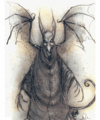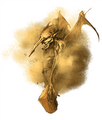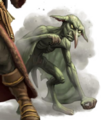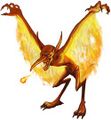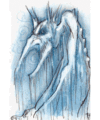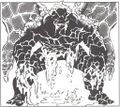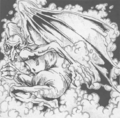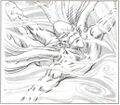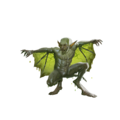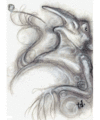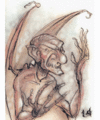Mephit

Mephits are a species of imp-like elemental monsters native to the Elemental Planes and Energy Planes of Dungeons & Dragons. Coming in a vast array of subspecies based on particular elements, their appearances, abilities and personalities all differ depending on their precise elemental affinity. The one trait they share in common is that they are all incredibly annoying.
They may or not have started in Fiend Factory as the (elemental) Imp. Fiend Folio posted them first, all on a Fire theme: Fire, Lava, Smoke, Steam. Later the 'Factory figured, why not Ice, so posted that one in #56.
Planescape
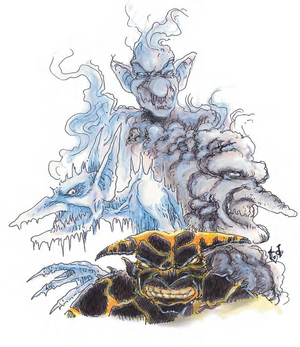
The Planescape setting had a thing for Mephits, expanding their numbers hugely. There is literally at least one mephit breed native to every single Elemental, Paraelemental and Quasielemental Plane you can think of. Except the Plane of Vacuum/Void, and even then, that's not certain.
In fact, Planescape's original lore is that whilst Cryonax is the only true Archomental of a Paraelemental/Quasielemental plane, unusually powerful mephits actually fill a similar role on all the others.
In Planescape lore, there's actually an established form of code language involving sending mephits to people you don't like, where the type(s) of mephit sent and the number of them sent conveys different responses or information. For obvious reasons, you only send mephits to rivals, enemies and other people you just don't like.
- Air: The gift of an air mephit indicates that the sender intends to either ambush the recipient or politically betray them. Naturally, these are usually timed to arrive after the plot is already in motion.
- Ash: These mephits are normally only sent to get the last word in, as they indicate a very strong and very rude refusal to correspond with the recipient anymore. They signal the recipient is no longer seen as being worth talking to.
- Dust: Receiving a Dust Mephit is a subtle threat, typically indicating that the giver has recognized some plot you are holding against him.
-
2e
-
-
4e
-
5e
-
PF
-
PF 2e
- Earth: Indicating a strong refusal to concede to demands, sending an Earth Mephit to somebody is a very firm declaration of "NO!"
- Fire: These mephits indicate displeasure with some recent action of the recipient's, with the number sent indicating just how mad the sender is.
-
1e
-
2e
-
4e
-
PF 1e
- Ice: These mephits indicate that the recipient is now officially forbidden from entering the home of the sender, with the number of Ice Mephits sent roughly indicating just how harshly they will be punished if they try.
-
Fiend Factory
-
1e
-
2e
-
-
4e
-
5e
-
PF 1e
-
PF 2e
- Lightning: Serving as a simultaneous warning and boast, the gift of a Lightning Mephit cautions the recipient to reconsider their tactics against the sender, as the sender has acquired some hidden ally who can swing things in their favor. These mephits are often, but not always, a bluff.
- Magma/Lava: One of these mephits is only sent in response to the sender having recently bested the recipient in some intellectual or diplomatic challenge. Basically, it's the sender's way of gloating.
-
1e
-
2e
-
4e
-
5e
- Mineral: An exception to the general rule of mephit code, the gift of a Mineral Mephit indicates that the sender is willing to compromise on something and is asking for more direct communication to be opened.
- Mist: Getting one of these indicates that someone close to you is an assassin, but the mephit itself almost never knows who. Given the usual audience for mephit codes, it's typically intended to inspire paranoia.
-
1e
-
2e
-
4e
- Ooze: These mephits are intended as sarcastic gifts, and basically serve as a way for the sender to say that the recipient is a weakling.
-
-
PF 2e
- Radiant: Like the Mineral Mephits, these are an exception to the generally hostile nature of the mephit code. The gift of a Radiant Mephit is essentially like receiving a white flag; it indicates that the sender wants to declare a truce.
- Salt: As the most unpleasant of all mephits, sending somebody a Salt Mephit serves as a declaration of open warfare between sender and recipient.
- Smoke: Similar in nature to Salt Mephits, but less extreme; the gift of a Smoke Mephit is a sign of insolence and contempt, and is usually used to declare a vendetta.
-
1e
-
2e
-
-
5e
- Steam: Serving as opposite of the Earth Mephit, the gift of a Steam Mephit indicates that the sender is agreeing to some request of the recipient. There is, however, a connotation of gloating — it serves as a way to say "yes, but I told you so!"
-
1e
-
2e
-
4e
-
5e
- Void: As mentioned above, the Plane of Void (or Vacuum, depending on where you look) has no native mephits, so "to get a Void Mephit" means to never get a reply.
- Water: Serving as formal answer to an Air Mephit, the gift of a Water Mephit indicates a sarcastic congratulation on a failed attempt by the recipient to trap or plot against the sender.
-
3e
-
4e
-
PF 2e
3e
All of the Mephits from AD&D returned to haunt D&D 3rd edition. Additionally, three new varieties manifested themselves in this edition;
Glass Mephits are native to the boundary regions of the Elemental Planes of Earth and Fire, characterized by their glossy skin and internal glow. They can spew gouts of molten glass over their foes, heat metal 2/day and blur themselves 1/day. They have the fast healing ability, but only when touching molten glass or a flame that is at least torch-sized. Introduced in the Sandstorm splatbook, we know nothing about their personalities.
Sulphur Mephits look like winged goblins made from living sandstone, hailing from the boundary regions of the Elemental Planes of Earth and Air. They can create a haboob - a swirling, blinding cloud of dust and grit that blinds and grinds away at anything caught within - centered on themselves 1/hour, and cast a stinking cloud 1/day. Their breath weapon is a nauseating cloud of gases that renders its victims unconscious, and their Fast Healing power only works when they are within fumes, such as volcanic gasses. Also from Sandstorm, we likewise don't know anything about this creature.
Mirror Mephits appeared in the adventure "Expedition to the Demonweb Pits". One of the few species native to the obscure lesser plane known as the Plane of Mirrors, they resemble winged goblins with smooth, mirrored skin, solidly black eyes, clawed fingers, and wings that resemble panes of clear glass. Their skin develops cracks and chips if they are wounded, and they shatter into a pile of glass dust. Their fast healing only works when they can see their reflection, their breath weapon is a cone of glass slivers, and they can cast mirror image and silent image at will as well as simulacrum 1/day. Though they are incredibly vulnerable to bludgeoning weapons and the shatter spell, they can reflect spells specifically targeted at them. Weirdly, their flavor text describes them as being able to see through and walk through reflective surfaces, but no mechanics for this ability are described! Mirror mephits enjoy teasing and tricking others; they are especially fascinated by the inhabitants of the Prime Material and spend great deals of time watching them - males tend to like watching spellcasters, arcane or divine, whilst females prefer rogues and warriors. They hate their plane for being so boring and readily answer summons - indeed, they love to try and tempt casters into calling them forth, making ridiculous promises of loyalty that are swiftly forgotten once they escape. They are often surprisingly adept at crafts such as stone carving, glassblowing, gem cutting or jewelry making, and have been known to become clerics to gods of trickery, illusions and shadow, although they are more likely to become wizards. Those who take the spellcaster's path often strive to construct wondrous items from mirrors, glass, enamel or semi-precious stones. A spell to summon mirror mephits is a 2nd level spell available to bards, clerics, sorcerers and wizards. They are most infamous for having Simulacrum as a SLA, so any called Mirror Mephit hands the caster one of the best spells in the game.
4th Edition
Reappearing in Dragon Magazine #421, the mephit was pretty unchanged in this edition. Natives of the Elemental Chaos, they became prank-loving and playful, but naturally servile, lesser elementals, frequently summoned by mages or more powerful elemental creatures to perform various minor tasks. Though they readily gravitate towards evil under the influence of an evil master, they are defined as impressionable and easy to please, which indirectly confirms that mephits who work for good masters will, in turn, become good creatures.
The list of mephits in this edition is shorter than that of the last two, cutting itself down to Earth Mephits, Air Mephits, Water Mephits, Fire Mephits, Dust Mephits, Smoke Mephits, Ice Mephits, Steam Mephits and Mist Mephits. Each retains its own unique appearance, abilities and personality based on its elemental affinity. Each has a melee attack and a close blast 3 breath weapon, as well as the regeneration ability, but each has at least one unique trait or ability - Earth Mephits being able to temporarily grow from their native Small size to Large sized for a round, for example.
5th Edition
Come 5th edition, mephits suffered a huge setback; to fit the new variant of the Great Wheel, they were stripped of most of their member species and reduced to only six races; Dust Mephits, Ice Mephits, Magma Mephits, Mud Mephits, Smoke Mephits, and Steam Mephits. This new lore is that mephits are only born when two (or possibly more) types of elemental energy interweave, which is also why they tend to be weaker than pure elementals.
All mephits in 5e have a breath weapon, a "Death Burst" ability that triggers on their death, and the ability to disguise themselves as innocuous elemental matter.
Monstergirls?
 | This article or section is about Monstergirls (or a monster that is frequently depicted as a Monstergirl), something that /tg/ widely considers to be the purest form of awesome. Expect PROMOTIONS! and /d/elight in equal measure, often with drawfaggotry or writefaggotry to match. |
Though you might think that mephits would pass unnoticed by the monstergirls crowd, it's not as implausible to sexualize them. A mephit is basically an elemental imp, and both of those get sexualized plenty often. Add in that genasi have had it in their lore that mephits are as likely to be their progenitors as genies since they first appeared in the pages of Planescape, to the point that Pathfinder's genasi elemental planetouched have alternate racial traits directly referencing mephit ancestry, and... well, you can do worse than a shortstack playful elemental imp, right?
Pathfinder eventually introduced the Changeling Familiar feat, which grants your familiar an alternate form of a teenage humanoid. With the sheer variety of familiar options in Pathfinder this feat unintentionally (?) explains where a lot of the weird human crossbreeds come from.
| The inhabitants of the Planes of Planescape | |
|---|---|
| Upper Planes | Aasimon • Angel • Animal Lord • Archon • Asura • Eladrin • Guardinals • Lillend |
| Middle Planes | Formians • Githzerai • Inevitable • Marut • Modron • Rilmani • Slaadi • Kamerel |
| Lower Planes | Alu-Fiend • Baatezu • Bladeling • Cambion • Demodand • Erinyes • Hag • Hordling • Imp • Kyton • Loumara • Marilith • Obyrith • Succubus • Tanar'ri • Yugoloth |
| Transitive Planes | Astral Dreadnought • Githyanki |
| Inner Planes | Azer • Elemental • Genie • Grue • Mephit • Salamander • Sylph |
| Sigil | Dabus • Cranium Rat |
| High-ups | Archangel • Archdevil • Archfey • Archomental • Demon Prince |

